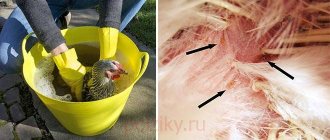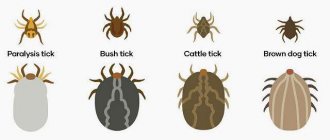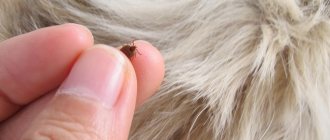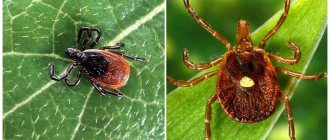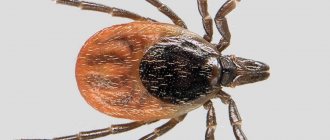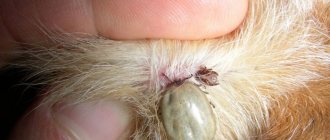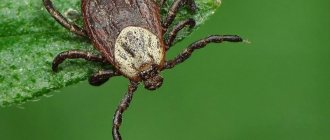At the beginning of April, the first ticks appear in Krasnoyarsk and the Krasnoyarsk Territory. By May, the number of people bitten increases sharply, and both adults and children, as well as pets, are at risk. If a person is bitten by a tick, carefully remove it and store it for further analysis in the laboratory. Laboratory testing of a tick in Krasnoyarsk will determine whether it was infectious, and if the result is positive, prompt initiation of treatment will help prevent terrible complications from encephalitis or Lyme disease.
Detailed description of the study
Infections carried by ixodid ticks are dangerous, and their symptoms are similar to each other. Some ticks can carry pathogens of several diseases at once, which complicates the course of the disease and complicates diagnosis.
Tick-borne encephalitis is a viral infection that affects the tissues of the brain and spinal cord and/or their membranes. You can get sick when ixodid ticks are active: in spring and summer. On average, 6 out of 10 ticks carry the virus across the country, but due to the uneven distribution of these insects, the likelihood of infection varies depending on the area. Regions in which a tick bite is likely to cause encephalitis are called endemic. In total, half of the country’s population lives in such territories. We have prepared a visual illustration of the prevalence of tick-borne encephalitis in Russia by region. https://www.gemotest.ru/news/119135/
A complete list of areas endemic for tick-borne encephalitis is provided on the Rospotrebnadzor website (https://www.mossanexpert.ru/novosti/?ELEMENT_ID=3386)
You can get sick not only from a tick bite. Domestic animals and birds can be carriers and sources of infection. Thus, you can become infected by consuming raw goat or cow milk. But tick-borne encephalitis is not transmitted from person to person.
When a virus enters the bloodstream, cells of the immune system capture it, but cannot neutralize it. It multiplies in them, new viral particles enter the lymph nodes, spleen, liver, where re-multiply occurs. When the number of viral particles has been increased, the virus enters the cells of the nervous system and meninges. Clinically, the disease begins acutely after an incubation period (7-35 days). Symptoms increase rapidly: the temperature rises to 38-39 °C, and a feeling of chills occurs. Weakness, drowsiness, headache and muscle pain, and possibly vomiting appear. All this lasts 2-4 days, after which relief occurs, which can be mistaken for recovery. Sometimes this is true, but in 20-30% symptoms return after a week. Due to damage to the nervous system, neurological pathologies are added. Motor disturbances occur: arms and legs begin to twitch or tremble, sometimes on the contrary - motor activity becomes more difficult to the point of paralysis, stiffness of the neck muscles occurs, which manifests itself in the inability to tilt the head or touch the chin to the chest. For the Far Eastern subtype of tick-borne encephalitis, the period of the disease is not typical: the disease begins even more acutely, the nervous system is affected already on days 3-5. The mortality rate from this subtype of the disease is higher: 20% versus 2% of the European form described above.
To prevent the disease, people living in or traveling to endemic regions are vaccinated. Immunity to tick-borne encephalitis develops within a month. If an infected tick bites a person, he is injected with anti-encephalitis serum. It is effective only for 4 days from the moment the tick bites. This is less than the incubation period, therefore, for timely measures to prevent infection, in the event of a tick bite, it must be submitted to the laboratory for analysis without waiting for the manifestations of the disease.
Lyme disease (borelliosis) is the most common tick-borne disease in the Northern Hemisphere. The most characteristic manifestation of the disease is a ring-shaped redness at the site of the bite, which is called erythema vagus. Erythema occurs on average 7-10 days after the bite, although this does not always happen. Even if redness does not appear, a tick bite is a reason to test the tick for Lyme borelliosis without waiting for symptoms of the disease, which on average appear two weeks from the moment of the bite. They include fever, weakness, headache and muscle pain. Sometimes cough, nausea, vomiting and diarrhea appear, and joint pain is often noted. As you can see, they are nonspecific - from the clinical picture it is difficult to understand that this is Lyme disease. Most often, the joints, nervous system and skin are affected as a result. The effectiveness of therapy and the outcome of the disease depend on timely diagnosis: without treatment, it can lead to disability and even death.
The nonspecificity of symptoms is due to the fact that the causative agent of the disease, a spiral-shaped bacterium (spirochete) of the genus Borrelia, affects various tissues and organs. Spirochetes enter the human body with the saliva of a tick during a bite.
You can become infected from May to September, especially likely in places where tick-borne encephalitis is endemic. If the ixodid tick carries pathogens of both diseases, a mixed infection may occur.
Two other diseases transmitted by Ixodid ticks are granulocytic anaplasmosis and monocytic ehrlichiosis. These are bacterial diseases. The causative agent of the first of them, Anaplasma phagocytophilum, affects granulocytes, cells of the immune system. The second disease is caused by bacteria of the genus Ehrlichia, they multiply in monocytes. Hence the names of these diseases. The symptoms of these infections are nonspecific and similar to each other: fever, weakness, headaches. They usually begin to appear within 12 days after the tick bite. In severe cases of the disease, damage to the skin, liver, kidneys, central nervous system, and bone marrow is noted. The infection is severe and has a high mortality rate, especially among immunocompromised people.
Don't rely on chance
If you find a tick attached to yourself or a loved one, do not treat it as a minor incident. Even if the tick was safely removed, and it seems to you that it did not cause any damage to your health, be sure to follow all the steps described below. It is no secret that a possible consequence of a tick attack is infection with deadly diseases: encephalitis, borreliosis, anaplasmosis, ehrlichiosis, etc. Immediately after a bite, it is impossible to independently assess and understand whether you are sick. Therefore, the main thing is to start taking action to avoid serious consequences. Giving up is the most unwise decision.
We have already written that tick-borne encephalitis is characterized by a five-year periodicity with a peak incidence in the second year and a subsequent three-year decline. 2022 is just the peak year.
References
1. Tick-borne viral encephalitis in adults. Clinical guidelines of the National Scientific Society of Infectious Diseases, 2014 2. https://www.rospotrebnadzor.ru/about/info/predpr/news_predpr.php?ELEMENT_ID=14010&sphrase_id... 3. Lyme disease in adults. Clinical recommendations of the Ministry of Health of the Russian Federation, 2016 4. Klimova Yu.A. et al. Human granulocytic anaplasmosis // Bulletin of the Peoples' Friendship University of Russia. Series: Medicine, 2022 5. Zlobin V.I. Tick-borne vector-borne infections // V.I. Zlobin, N.V. Rudakov, I.V. Malov. – Novosibirsk: Nauka, 2015. – 224 p.
Ticks in Krasnoyarsk 2019
This year the warmth arrived much earlier; ticks awoke after winter hibernation back in March. So far, no cases of viral encephalitis, borreliosis, or other infections have been registered.
To pick up a parasite, you don’t have to go deep into the forest; pests can hide in a city park, in the grass near a lake, or in the yard of your own home. Last year, the first tick was brought into a Krasnoyarsk apartment in March by a pet. The tick season will begin in March-April and end closer to October.
Preventative measures for tick bites
To avoid becoming a victim of blood-sucking parasites, you need to remember about protective measures. Even vaccinated people should be careful.
- Use repellents.
- Protect your skin with cuffed clothing.
- Wear hats when going into the forest.
- Do not use sweet perfumes, which attract parasites.
- In the forest you should inspect each other every 2 hours and remove parasites from clothes.
- Upon returning home, throw everything in the wash, take a shower, and carefully examine your body.
- Check your pets for parasites.
- Treat areas near the house, gardens, and country houses. For this purpose, acaricidal drugs are used; Tsifox, Taran, and Doctor Klaus have proven themselves well.
The forecast and rules of behavior are no different from previous years. The only difference is that people have begun to take the issue of prevention much more seriously, so cases of infection appear much less frequently.
Treatment for ticks in Krasnoyarsk
The city authorities plan to spend 1 million 575 thousand rubles on anti-tick treatment of the area, which is significantly higher than last year’s amount. The total cultivation area is 315 hectares. The sites are determined by Rospotrebnadzor specialists based on monitoring from the previous year.
- Sovetsky district: Vesny street, 17; Yastynska, 18/1 and Yastynska, 19a; three plots in the area of the Arena Sever sports complex; Abytaevskaya, 9; Urvantseva street, 4 and 6;
- Central District: 58 hectares of public gardens in the Central District of the city, including Central Park;
- Sverdlovsk region: the bank of the Bazaikha River, the area of the Roev Ruchey flora and fauna park, the area around the Bobrovy Log fun park (and the park itself, at the expense of its own budget), the mountain at the Yenisei station, the area of the Stolby nature reserve, the vicinity of Torgashino and Vodnikov ;
- Oktyabrsky district: the vicinity of the fruit and berry station, the lower and upper Akademgorodok, Studgorodok, Vetluzhanka, the Nikolaevskaya Sopka area, Siberian Federal University and the Udachny state farm.
Treatment with modern effective drugs is planned to be carried out until May 20, after which specialists will double check the result. If necessary, the area will be re-disinfested.
Where to go if bitten by a tick in Krasnoyarsk
Tick bite
You can remove the parasite yourself or go to a specialist. There are several options for where to remove a tick in Krasnoyarsk. Go to the clinic at your place of residence; the parasite will be removed at a sanitary inspection station, at a trauma center, or at an infectious disease specialist’s office.
Highly qualified assistance at any time of the day will be provided by specialists at the First Private Trauma Center at the Clinic in Severny. Doctors remove the tick, send it for analysis, treat the bite site, and carry out emergency seroprophylaxis against tick-borne encephalitis. If you have an insurance policy, assistance is free. Address 9 May, 19a. Phone, website clinsev.ru. based at the Clinic in Severny.
Vaccinations against tick-borne encephalitis in Krasnoyarsk
Vaccination against tick-borne encephalitis
Conducted with domestic and foreign vaccines at the expense of citizens, employers, and municipal authorities - schoolchildren, pensioners. Tick vaccination is available from the age of one, but the first tick-borne encephalitis vaccination is recommended for children at 3 years of age. Adults should seek help from private clinics.
Schedule – 2 vaccinations per year with a break of 4-6 months. A year later, another vaccine. Subsequently every 3 years. You can get a tick vaccination at the following institutions:
- Medical, st. Urvantseva, 14, cost: 800 – 1100 rubles, t. 277-40-00, med-nad.ru
- Clinic on Kirenskogo, st. Academician Kirenskogo, 32, cost: 800 rubles, t. 205-28-00, clinsev.ru
- KrasBioMed-Immuno, st. Uritskogo, 120, office, cost: 650 – 700 rubles, t. 211-07-45, krasbiomed.rf
- Clinic "Family and Health", st. Dubrovinsky, 106, cost: 660-700 rubles, t. 227-53-53, no time to get sick.rf
- KSAU Regional AIDS Center, st. K. Marksa, 45, cost: 700 – 1210 rubles, t. 226-84-10, aidskrsn.ru
Working hours from 8.00 to 18.00, break from 12.00 to 13.00.
Read also
Sales of suitcases forgotten at the airport have become fashionable around the world.
In Russia, such luggage is most often sent to the poor and to orphanages.
Participants of the #DirectorVpokhod project returned to Moscow
7 teams of educational organizations of the capital were met at the Kazansky railway station [photo, video]
The survey can be considered completed: a site for a temple is being chosen in Yekaterinburg
More than 50 thousand Yekaterinburg residents came to vote
At the cost of his life he tried to save the golden raft: a memorial plaque to the hero-customs officer was installed on a rock near the Yenisei
He died in 1930 while fulfilling his duty
Saratov said goodbye to the murdered Liza Kiseleva: “This tragedy shook everyone up”
Thousands of townspeople saw off the dead girl on her last journey [photo, video]
Tina Kandelaki and Maxim Shevchenko on the air of Radio “Komsomolskaya Pravda”
Experts will talk about the main events in the country and the world live on radio “Komsomolskaya Pravda” in the program “We’ll Live Until Monday” [video broadcast]
Russian sailors saved Americans dying at sea
37 years ago, the crew of a Soviet ship brought on board two miraculously surviving shipwreck participants.
Thousands of people in Saratov came to say goodbye to Liza Kiseleva
The temple could not accommodate everyone, people with flowers are waiting for the end of the funeral service on the street
Siberian woman lost 45 kilograms for a guy from a dating site and left him
The boyfriend initially rejected Anya, and when he appreciated the girl’s slender figure and asked her out on a date, she realized that she didn’t need him
It will remain warm in Krasnoyarsk for a whole week
The chance of precipitation is minimal
FBK and Fra Diavolo, Dubrovsky fled abroad, bribes like greyhounds, deputy Ugolinchuk and the capital Dobryni
Personal view of publicist Maxim Sokolov on the main events of the past week
Age category of the site 18+

